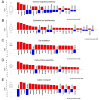Human lens epithelial cells induce the inflammatory response when placed into the lens capsular bag model of posterior capsular opacification
- PMID: 39959166
- PMCID: PMC11829793
Human lens epithelial cells induce the inflammatory response when placed into the lens capsular bag model of posterior capsular opacification
Abstract
Purpose: Cataracts are typically treated by phacoemulsification followed by intraocular lens implantation. Studies of mouse models of cataract surgery have revealed that lens epithelial cells rapidly remodel their transcriptome to express proinflammatory cytokines after lens fiber cell removal, but it is currently unknown whether this response is conserved in human lenses. This study seeks to fill this knowledge gap.
Methods: Human cadaver eyes from 70 to 89 year old individuals were prepared for the human capsular bag model of cataract surgery. The central epithelium was preserved in RNAlater during culture preparation, then the equatorial epithelium was either immediately preserved in RNAlater after the culture was created, or 24 h later. Gene expression profiles were generated by bulk sequencing of RNA isolated from these tissue samples. The transcriptomic response of human cadaver-derived lens epithelial cells to culture in this "capsular bag" model was characterized by bioinformatic analysis. The human response was directly compared to that of 24-month-old mouse lens epithelial cells subjected to fiber cell removal surgery.
Results: Human lens epithelial cells remodel approximately a third of their transcriptome by 24 h after surgery, and like mice, this response consists of induction of proinflammatory cytokine genes, upregulation of fibrotic markers and downregulation of genes controlling the lens epithelial phenotype.
Conclusions: These observations demonstrate that humans and mice have similar responses to cataract surgery and support the use of mice to study the response of lens epithelial cells to cataract surgery, suggesting that identified injury response mechanisms can be leveraged to elucidate new approaches to improve the outcomes of cataract surgery.
Copyright © 2024 Molecular Vision.
Figures



Similar articles
-
Surgical interventions for bilateral congenital cataract in children aged two years and under.Cochrane Database Syst Rev. 2022 Sep 15;9(9):CD003171. doi: 10.1002/14651858.CD003171.pub3. Cochrane Database Syst Rev. 2022. PMID: 36107778 Free PMC article.
-
Intraocular lens optic edge design for the prevention of posterior capsule opacification after cataract surgery.Cochrane Database Syst Rev. 2021 Aug 16;8(8):CD012516. doi: 10.1002/14651858.CD012516.pub2. Cochrane Database Syst Rev. 2021. PMID: 34398965 Free PMC article.
-
Trifocal versus extended depth of focus (EDOF) intraocular lenses after cataract extraction.Cochrane Database Syst Rev. 2024 Jul 10;7(7):CD014891. doi: 10.1002/14651858.CD014891.pub2. Cochrane Database Syst Rev. 2024. PMID: 38984608 Free PMC article.
-
Prescription of Controlled Substances: Benefits and Risks.2025 Jul 6. In: StatPearls [Internet]. Treasure Island (FL): StatPearls Publishing; 2025 Jan–. 2025 Jul 6. In: StatPearls [Internet]. Treasure Island (FL): StatPearls Publishing; 2025 Jan–. PMID: 30726003 Free Books & Documents.
-
Accommodative intraocular lens versus standard monofocal intraocular lens implantation in cataract surgery.Cochrane Database Syst Rev. 2014 May 1;2014(5):CD009667. doi: 10.1002/14651858.CD009667.pub2. Cochrane Database Syst Rev. 2014. PMID: 24788900 Free PMC article.
Cited by
-
CD24 is required for sustained transparency of the adult lens.Exp Eye Res. 2025 Jun;255:110347. doi: 10.1016/j.exer.2025.110347. Epub 2025 Mar 18. Exp Eye Res. 2025. PMID: 40112946
-
LIRTS Viewer: A Web-Based Resource to View the Transcriptional Response of Lens Epithelial Cells to Injury.Invest Ophthalmol Vis Sci. 2025 Jul 1;66(9):53. doi: 10.1167/iovs.66.9.53. Invest Ophthalmol Vis Sci. 2025. PMID: 40679332 Free PMC article.
-
Corneal Endothelial Cell Loss Following Cataract Surgery in Patients with Type 2 Diabetes Mellitus: A Comprehensive Review.Biomedicines. 2025 Jul 15;13(7):1726. doi: 10.3390/biomedicines13071726. Biomedicines. 2025. PMID: 40722796 Free PMC article. Review.
-
Whole Exome Sequencing Study Uncovers Novel Candidate Genes and Protein-Coding Variants for Cataract.Invest Ophthalmol Vis Sci. 2025 Aug 1;66(11):32. doi: 10.1167/iovs.66.11.32. Invest Ophthalmol Vis Sci. 2025. PMID: 40801674 Free PMC article.
-
Transcriptomic Analysis of Human Lens Epithelium Tissue With and Without Cataract Surgery: Uncovering Novel Pathways of Post-Surgical Lens Epithelium Remodeling.Invest Ophthalmol Vis Sci. 2025 Jul 1;66(9):28. doi: 10.1167/iovs.66.9.28. Invest Ophthalmol Vis Sci. 2025. PMID: 40643341 Free PMC article.
References
-
- Wang W, Yan W, Müller A, He M. A Global View on Output and Outcomes of Cataract Surgery With National Indices of Socioeconomic Development. Invest Ophthalmol Vis Sci. 2017;58:3669–76. - PubMed
-
- Abdulhussein D, Abdul Hussein M. WHO Vision 2020: Have We Done It? Ophthalmic Epidemiol. 2023;30:331–9. - PubMed
-
- Liu YC, Wilkins M, Kim T, Malyugin B, Mehta JS. Cataracts. Lancet. 2017;390:600–12. - PubMed
-
- Lamoureux EL, Fenwick E, Pesudovs K, Tan D. The impact of cataract surgery on quality of life. Curr Opin Ophthalmol. 2011;22:19–27. - PubMed
MeSH terms
Substances
Grants and funding
LinkOut - more resources
Full Text Sources
Medical
Miscellaneous

